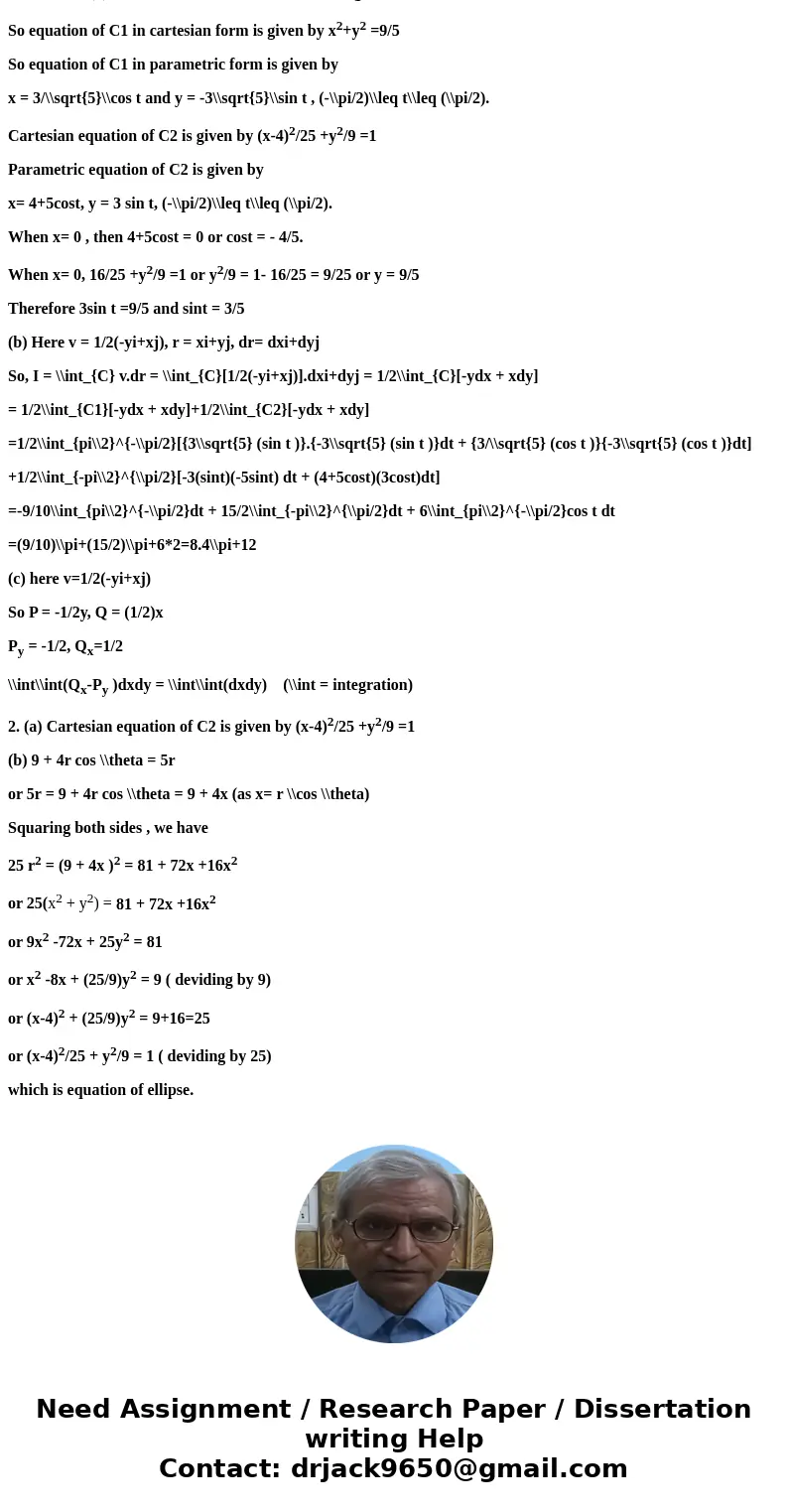Thanks Let R be the region shown above bounded by the curve
Thanks
Let R be the region shown above bounded by the curve C-C1UC C1 is a semicircle with centre at the origin O and radius G is part of an ellipse with centre at (4,0), horizontal semi-axis a = 5 and vertical semi-axis b-3. I. (a) Parametrise C1 and C2. Hint: Use t :-to to as limits when parametrising C3 and erplain why cos(to) =--and sin(to)-- (b) Calculate where v = -y1 + r.) (c) Use Green\'s theorem and your answer from 1(b) to determine the area of R and then verify that it is less than ab. 2. (a) Give the cartesian equation for the ellipse used to define C2 (b) Show that 9 + 4r cos 5r is the equation of that ellipse when written in polar coordinates (r, 0). Hint: Square both sides first. (c) Calculate using polar coordinates. Hint: Integrate with respect to r first and then Explain why the limits on the outer integral should be- 3. If T(r) = T/r3 is the temperature profile in the region R, then use the previous results to calculate the average temperature in R when T-1000. Verify that the average temperature is between the minimum and maximum temperatures in RSolution
Solution: 1. (a) C1 is a semi circle with centre at origin and radius 9/5.
So equation of C1 in cartesian form is given by x2+y2 =9/5
So equation of C1 in parametric form is given by
x = 3/\\sqrt{5}\\cos t and y = -3\\sqrt{5}\\sin t , (-\\pi/2)\\leq t\\leq (\\pi/2).
Cartesian equation of C2 is given by (x-4)2/25 +y2/9 =1
Parametric equation of C2 is given by
x= 4+5cost, y = 3 sin t, (-\\pi/2)\\leq t\\leq (\\pi/2).
When x= 0 , then 4+5cost = 0 or cost = - 4/5.
When x= 0, 16/25 +y2/9 =1 or y2/9 = 1- 16/25 = 9/25 or y = 9/5
Therefore 3sin t =9/5 and sint = 3/5
(b) Here v = 1/2(-yi+xj), r = xi+yj, dr= dxi+dyj
So, I = \\int_{C} v.dr = \\int_{C}[1/2(-yi+xj)].dxi+dyj = 1/2\\int_{C}[-ydx + xdy]
= 1/2\\int_{C1}[-ydx + xdy]+1/2\\int_{C2}[-ydx + xdy]
=1/2\\int_{pi\\2}^{-\\pi/2}[{3\\sqrt{5} (sin t )}.{-3\\sqrt{5} (sin t )}dt + {3/\\sqrt{5} (cos t )}{-3\\sqrt{5} (cos t )}dt]
+1/2\\int_{-pi\\2}^{\\pi/2}[-3(sint)(-5sint) dt + (4+5cost)(3cost)dt]
=-9/10\\int_{pi\\2}^{-\\pi/2}dt + 15/2\\int_{-pi\\2}^{\\pi/2}dt + 6\\int_{pi\\2}^{-\\pi/2}cos t dt
=(9/10)\\pi+(15/2)\\pi+6*2=8.4\\pi+12
(c) here v=1/2(-yi+xj)
So P = -1/2y, Q = (1/2)x
Py = -1/2, Qx=1/2
\\int\\int(Qx-Py )dxdy = \\int\\int(dxdy) (\\int = integration)
2. (a) Cartesian equation of C2 is given by (x-4)2/25 +y2/9 =1
(b) 9 + 4r cos \\theta = 5r
or 5r = 9 + 4r cos \\theta = 9 + 4x (as x= r \\cos \\theta)
Squaring both sides , we have
25 r2 = (9 + 4x )2 = 81 + 72x +16x2
or 25(x2 + y2) = 81 + 72x +16x2
or 9x2 -72x + 25y2 = 81
or x2 -8x + (25/9)y2 = 9 ( deviding by 9)
or (x-4)2 + (25/9)y2 = 9+16=25
or (x-4)2/25 + y2/9 = 1 ( deviding by 25)
which is equation of ellipse.


 Homework Sourse
Homework Sourse